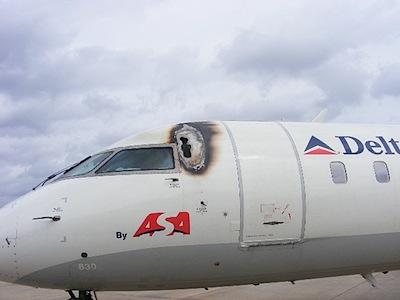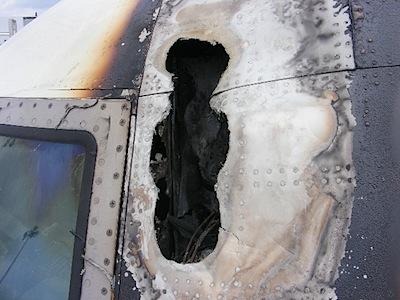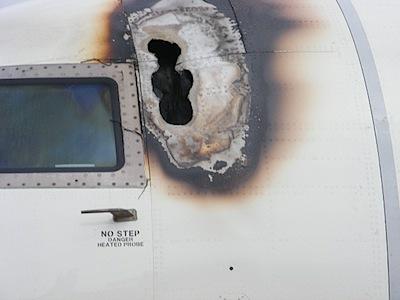Claim: Photographs show an airliner that was struck by lightning.
Example: [Collected via e-mail, August 2009]
Thanks to one of our American Airlines' pilot friends who sent us these photos this morning of an Atlantic Southeast Airlines/Delta Connection aircraft, after it suffered a lightning strike. If these photos don't scare the you-know-what out of you, I'm not sure what would. As he said to me in his note, "Wonder what the Captain's seat cushion looked like after this..."



Origins: Passengers anxious about traveling by air can conjure up any number of aircraft disaster scenarios to fret about: collisions with other aircraft, catastrophic engine failures due to bird strikes, extreme weather phenomena, etc. Another entry in that
litany of fears might be apprehension about an airliner's being struck by lightning mid-flight, with the photographs displayed above supposedly depicting the aftermath of such an occurrence.
However, although these pictures do depict real damage suffered by an airliner, the cause of the damage had nothing to do with lightning, the incident occurred while the plane was on the ground and empty of passengers, and the mishap not result in any injuries. According to the National Transportation Safety Board (NTSB), the incident captured in these photos took place in Tallahassee, Florida, on 28 February 2009, and the visible damage was the result of a cockpit fire that burned through the skin of the aircraft:
On February 28, 2009 at approximately 0840 EST, a Bombardier Aerospace CRJ-200, N830AS, experienced a fire on the ground shortly after external power was applied to the airplane in preparation for flight. The flight attendant and captain of the aircraft first became aware of the situation due to an unusual hissing sound which was quickly followed by smoke and signs of a fire. They immediately evacuated the airplane via the airstair without injuries. They were the only individuals on the airplane at the time. The fire department extinguished the fire, but not before it had burned a hole through the left upper cockpit crown skin. The airplane was registered to and operated by Atlantic Southeast Airlines as flight 5563 under the provisions of 14 Code of Federal Regulations Part 21. The flight was to be from Tallahassee Regional Airport (TLH), Tallahassee, Florida, to Hartsfield Jackson Atlanta International Airport (ATL), Atlanta, Georgia.
As noted in an article by USA Today weather editor Jack Williams, lightning strikes on airplanes are not uncommon occurrences, but such events rarely result in disaster due to a number of related safety features:
But, lightning has not caused an airliner crash in the USA or of a U.S. airline plane anywhere in more than Protection begins with the fact that airliners, and the majority of other airplanes, are made of aluminum, which is a very good electrical conductor. A lightning bolt's electricity flows along the airplane's skin and into the air. Lightning protection goes far beyond airplanes being good conductors of electricity, and the last airline crash in the USA blamed on lightning was more than This led to rules requiring that airplanes have built-in systems that ensure that a spark will not ignite fuel or fuel vapors in tanks or fuel lines. Then, during a 1980s lightning research project, NASA flew an This led to regulations that require aircraft electrical and electronic systems, as well as fuel tanks and lines, to have built-in lightning protection.
Lightning regularly strikes airplanes. In fact, as far as anyone knows, the odds are that each airliner in the USA will be hit by lightning once a year. (Obviously some would be hit more than once, some not at all.)
Last updated: 16 July 2014
Sources: |
Williams, Jack. "Answers: Does Lightning Hit Airplanes." USA Today. 1 June 2004.
